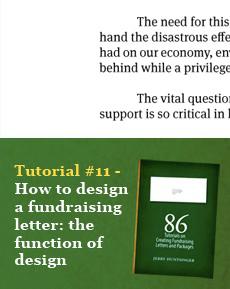Tutorial 11: How to design a fundraising letter: the function of design
Letters are not supposed to be pretty or attractive, or large or small, or long or short, or colourful or stylish…
- Written by
- Jerry Huntsinger
- Added
- February 18, 2019

... they are supposed to be read. That’s all.
And the function of ‘art’ is to:
- Provide a design to ensure the letter is read.
- Organise the distinctive elements of the letter.
You must be aware that unless you are dealing with a direct mail layout person, your artist may destroy the purpose of your letter. You are the creator. You must control and dictate the layout of the letter. The motivational techniques you employ will be visual, as well as verbal.
In brief, the function of art for a fundraising letter is to ensure that the letter stands
out in the mailing piece as a distinctive personal message. Whether you design the letter yourself or work with an artist, you must end up with a letter that really looks like a letter.
Can you separate design and copy?
I usually have a rather definite design in mind before I begin writing the letter. For example, I know:
- How much good material I have at hand to put in the letter.
- Whether it is to be personalised or a form letter.
- The type of person who will be reading the letter.
- The type of format most likely to motivate the reader.
This means that if the letter is to be personalised it probably will be two pages or less, with a more conservative look.
If the mailing is to be mass-produced and reach a mass audience it will probably be more than two pages, with a format that will put an emotional story or picture right up front.
And I have a pretty good idea about how I plan to have it produced.
As a general rule, the more personal the format and the contents the more a ‘letter-like’ design will be necessary.
Back to basics: the six vital elements
Over time, people have come to accept and recognise certain characteristics that make a letter ‘look’ like a real letter.
- Date line – a letter is a personal message coming from a distance, written in an exact point in history, even for mass-produced letters. Design your letter so the date is a dominant feature at the top of the letter. Separate it from all the other copy. Don’t abbreviate the month. Remember, a specific date increases personalisation. Without a date, a letter becomes a brochure.
- Name and address – a letter, to be personal, must be addressed to someone. In a written or computer letter, the name and address usually appear at the top of the sheet. In a form letter you can often put in a headline and still maintain the ‘look’ of a letter. Even though the reader is accustomed to looking for her name, if the headline intrigues her, you have made a successful beginning.
- Whether or not you use an actual name and address, or a headline, the space involved must be blocked out and separated from all other copy.
- For a headline, use underlining; rarely use all capital letters.
- A three- or four-line headline is usually best for balance.
- Dear somebody – once in a while you can omit the ‘dear friend’ in a form letter, but it’s rare. Leaving out the ‘dear friend’ is like answering the telephone and saying, ‘Yeah?’
Don’t fight against established traditions at this level. You build a trust relationship with the reader by letting her feel comfortable.
At times you can use prepositional phrases:
Dear friend of children, dear friend of animals.Or, you can use a descriptive phrase:
Dear concerned friend, dear homeowner, dear businessman.When in doubt, just plain old ‘dear friend’ will always do the job.
- Body copy – don’t fight indented paragraphs, standard font, short paragraphs. Don’t crowd things, make it easy for the reader to move along. Use a good large ‘typewriter’ type. Your donors are mostly folks who wear glasses.
- Signature – this traditionally falls in the lower right-hand corner. Give it space. Don’t crowd it.
Don’t use too many sweet words: just ‘sincerely’, ‘sincerely yours’ or ‘yours sincerely’ is adequate.
- Postscript – this is the ‘Oh, yes, I almost forgot to tell you ... ’ part of the letter. Keep the PS in a prominent position.
You may be wondering, ‘what about the letterhead, the logo, the board, the return address’? Forget them, for the present.
‘That certain look’ includes six features – no more, no less. Your entire design problem is to make these six features give your letter a genuine look.
And when you use them effectively, you can find a place for your sacred logo, board name, pictures and all sorts of good things.
© SOFII Foundation 2010-2014.

















